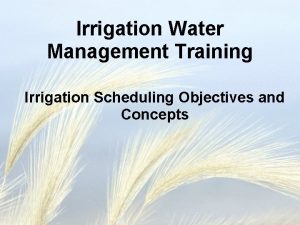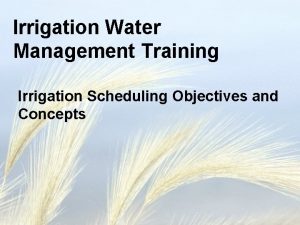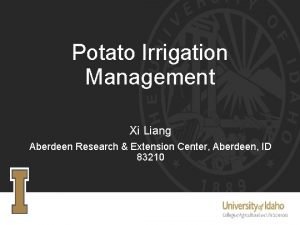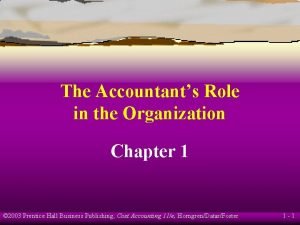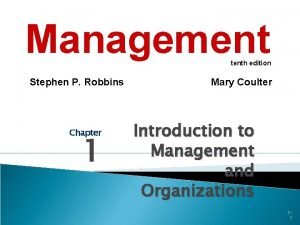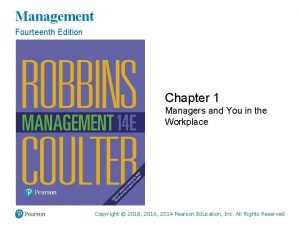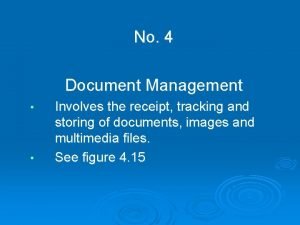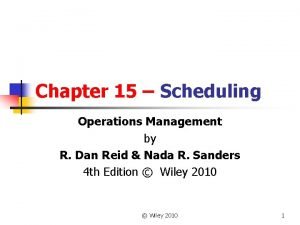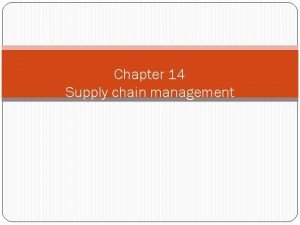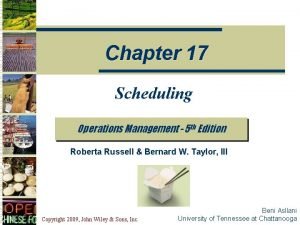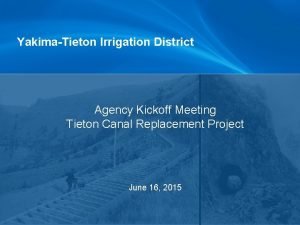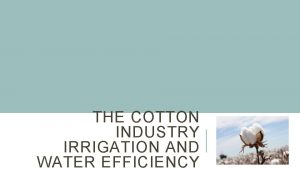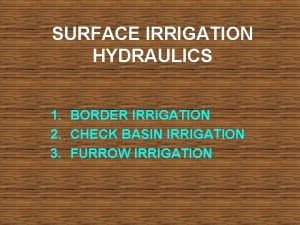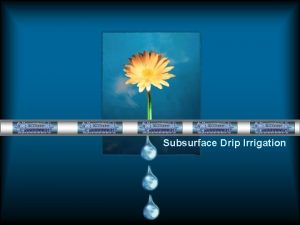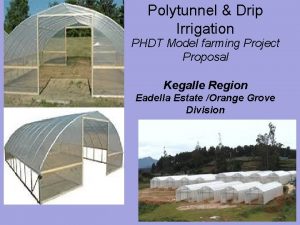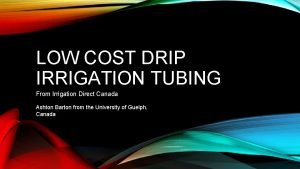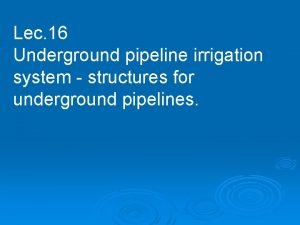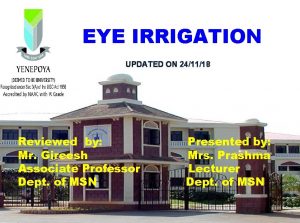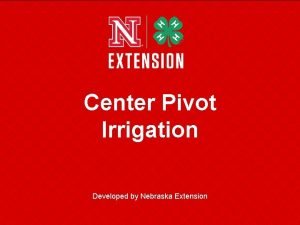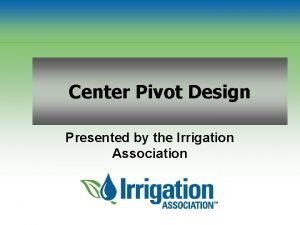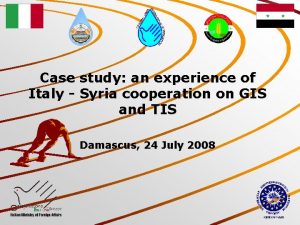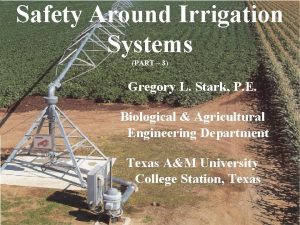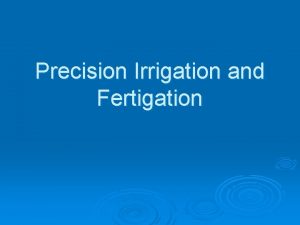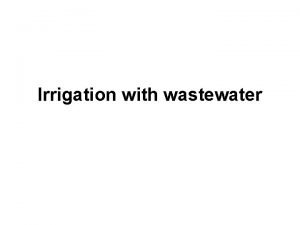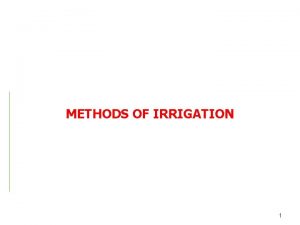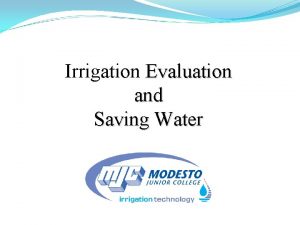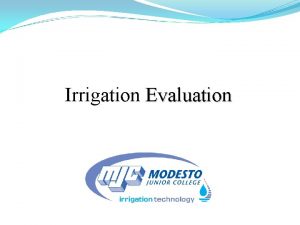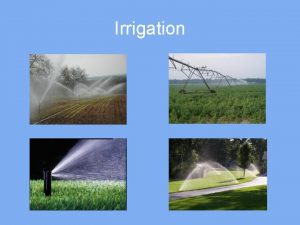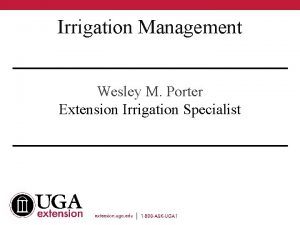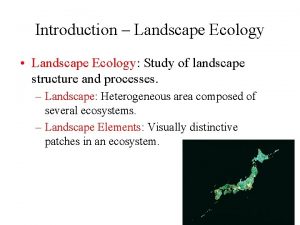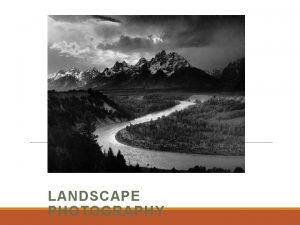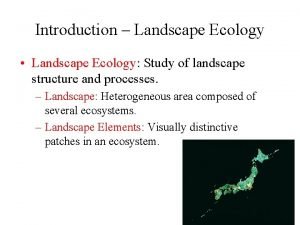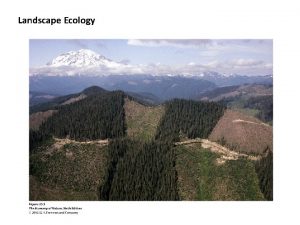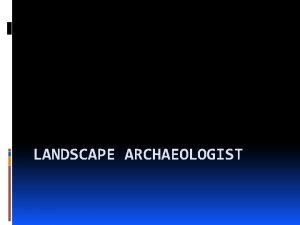Water Management in the Landscape Irrigation Scheduling Involves













































































- Slides: 77

Water Management in the Landscape

Irrigation Scheduling Involves Applying the Right Amount of Water at the Right Time

What Factors are Involved in Irrigation Scheduling? Plant Water Use Soil Water Holding Capacity Water Infiltration Rate Plant Rooting Depth Irrigation System Output

Plant Water Use Varies Among Species Influenced by Microclimate

ET (Landscape Species) = ETo (reference evapotranspiration) x Kc (crop coefficient)

Reference Evapotranspiration (ETo) ETo = The amount of water used by a large uniform planting of a cool-season grass growing 3 -6 inches tall and given unlimited water.

Factors that Determine ETo Solar radiation Temperature Wind speed Relative humidity

www. cimis. water. ca. gov California Irrigation Management Information System CIMIS Station

Avg. Monthly Irrigation Percentages

Average (mean) ETo Inland Valley San Jose San Francisco

Lawns and Groundcovers More ‘Crop. Like’ Than Mixed Species with Varying Densities and Microclimates Kc (warm season turf) =. 6 Kc (cool season turf) =. 8

Lawns and Groundcovers More ‘Crop. Like’ Than Mixed Species with Varying Densities and Microclimates Kc (warm season turf) =. 6 Kc (cool season turf) =. 8

‘Crop’ of Turf

UC ANR’s Lawn Watering Guide Based on Warm Season Kc =. 6 and Cool Season Kc =. 8 and a Distribution Uniformity of 80% http: //ucanr. org/freepubs/docs/8 044. pdf

How to Use the ‘Lawn Watering Guide’ Determine type of lawn (warm vs cool season turf) Conduct a ‘Can Test’ to determine sprinkler system output and distribution uniformity Determine how long to irrigate (minutes per week) based on climatic chart provided Determine maximum amount of time to water per event until runoff just begins

Identify and repair leaks, low heads, broken sprinklers, unmatched sprinklers and pressure and spacing problems

Improve Distribution Uniformity to Improve Turf and Groundcover Health and Reduce Water Waste

Good (top) and Poor (bottom) Distribution Uniformity

Water cycling may be necessary to avoid run-off. Divide the total amount of water required per day into 2 -4 cycles. Apply water as close to initial event as possible before soil dries out.

Drosanthemum sp. (Iceplant) also ‘crop-like’

Fruit Tree Water Requirements are Determined by Canopy Size

Converting Inches to Gallons (For Drip/Microsprinkler Systems) Conversion factor = 0. 62 Area 1 ft. x 1 in. contains 0. 62 gal. Estimated gallons needed = Est. water needed (in. ) x area (sq. ft. ) x 0. 62 Example: ET(orchard) for 1 week = 1. 35 in. x 800 sq. ft. x 0. 62 = 670 gal. There are 64 1 -gal. /hr. emitters 670 gal. / 64 gal. /hr = 10. 5 hrs. per week

Tree fern is considered a high water user (Dicksonia antarctica and Cyathea cooperi)

Flannel Bush is Drought Resistant (Fremontodendron spp. )

Star Jasmine less drought resistant than Cotoneaster

Plant Requirements Based on UC ANR Research Potentilla tabernaemontani 0. 5 - 0. 75 Sedum acre 0. 25 Cerastium tomentosum 0. 25 Liquidambar styraciflua 0. 20 Quercus ilex 0. 20 Ficus microcarpa nitida 0. 20 Hedera helix Ôneddlepointo 0. 20 Drosanthemum hispidum 0. 20 Gazania hybrida 0. 25 -0. 50 Vinca major 0. 30 Baccharis pilularis 0. 20

Plant ET often higher than actual water required for acceptable performance (Mesquite and Ficus)

Water Needs of the Same Species Varies Depending on Microclimate Landscape plants in heat islands require up to 50% more water than the same species in park settings






Shade Vs Full Sun


Hydrozone : Plant Species with Similar Water Needs Together

If Hydrozoning Wasn’t Done at Establishment Add drip lines, emitters, or minisprinklers from plants being underwatered; water for less time Or remove them or adjust them down from plants being overwatered; water longer Split one zone into two more similar zones (add a valve)

Second Drip Line Added (Inline emitter tubing)



Plant Density Affects Water Requirement

Multi-tiered canopy uses more water than single tier canopy


Low Density Planting

DWR WATER BUDGET *MAWA = (ETo) (0. 7) (LA) (0. 62) ETo = Reference Evapotranspiration (inches per year) 0. 7 = ET Adjustment Factor LA = Landscaped Area (square feet) 0. 62 = Conversion factor (to gallons) *Maximum Applied Water Allowance = _______ gallons/year

Example of Maximum Applied Water Allowance (MAWA) Fresno, CA (annual historical ETo = 51. 1 in) Hypothetical Landscape Area = 50, 000 sq ft MAWA = (Eto) (0. 7)* (LA) (0. 62)** MAWA = (51. 1) (0. 7) (50, 000 sq ft) (0. 62) MAWA = 1, 108, 870 gallons per year *ET Adjustment Factor ** Conversion factor from inches to gallons

Determining When To Irrigate is as Important as Knowing How Much Water to Apply

Factors Affecting Frequency of Irrigation Soil water holding capacity Water infiltration rate Depth of rooting Irrigation method and output

Determine Soil Water Holding Capacity

Determine Soil Water Holding Capacity

Use the ‘Feel’ Test Dry Medium Wet

Depths to Irrigate Turf – 8 to 12 in. Shrubs - Small – 1 ft. - Large – 2 ft. Trees - Small – 2 ft. - Large – 3 ft.

Monitor Soil Moisture Soil probe Soil sampling tube

“Smart” Irrigation or Weather-Based Controllers • Controller adjusts scheduling based on changes in the weather. • Scheduling is based on weather conditions, plant type, and site conditions. • Incorporate ET into irrigation scheduling. • Many types of controllers now available. • Early studies show a savings of 32 -42 gallons/day and a 64 -71% reduction in surface runoff.

Choosing a “Smart” Irrigation or Weather. Based Controller l Measurement of weather conditions – Limited on-site measurements with multiple sensors such as temperature and solar radiation to calculate ET. – Historic ET as a function of site location. – Full set of data from local weather stations or network of sensors transmitted to controller. l Professional installation recommended by most manufacturers. Replacement controller versus receiver add-on. Automatic run time calculation with adjustment. Optional rain sensor or other gauges. l l l

http: //www. irrigation. org/SWAT/Industry/ia-tested. asp


Other Methods to Conserve Water

Reduce and/or Remove Unnecessary Turfgrass

Add Infiltration Basins Shallow depression dug into the landscape. Utilized on flat or gradually sloping land. Collects runoff from surrounding landscape. Called a “Rain Garden” in the Northwest, Northeast, and Midwest U. S.

Creating an Infiltration Basin Position close to and lower than hardscapes where runoff will naturally flow into them. Think about the vegetation you want to grow in and around the basin. Usually between 9” to 24” deep depending on soil type.

Other Considerations … Poorly draining soils require additional attention. Supplemental water may be required to establish vegetation. Use native plant species. Vegetation in bottom of basin should tolerate wetter conditions.

Irrigate Using Drip Systems to Reduce Soil Evaporation and Apply Water Directly into Root Zones

Minimize the use of water to clean sidewalks and driveways

Never use water to clean up chemical spills

Remove weeds that compete with landscape plants for water

Increase Mowing Heights of Lawns to Encourage Deep Roots

Always Select Species Adapted to the Climate and Microclimate

Irrigate Established Plants Deeply and Infrequently Avoid watering every day Water a few inches below the current root system during each watering to encourage deep rooting

Improve Water. Holding Capacity and/or Drainage of Problem Garden Soils with Compost

Apply Mulch Around Plants

Avoid Overfertilizing (Increases Water Requirement)

Sources of Information • http: //camastergardeners. ucdavis. edu/ • http: //ucanr. org/blogs/camastergardeners/

Sources of Information UC Guide to Healthy Lawns http: //www. ipm. ucdavis. edu/TOOLS/TURF/ index. html (Includes interactive scheduling web pages) Lawn watering guide for Calif. http: //anrcatalog. ucdavis. edu/pdf/8044. pdf www. wateright. org (CSU Fresno) Complete residential scheduling, with tutorial

Sources of Information ● A Guide to Estimating Irrigation Water Needs of Landscape Plantings in California: The Landscape Coefficient Method and WUCOLS II (UCCE, DWR 2000, Free of charge) http: //www. owue. water. ca. gov/docs/wucols 00. pdf

Sources of Information ● Rainwater Harvesting for Drylands and Beyond ● Volume 1 and 2 by Brad Lancaster ● http: //www. harvestingrainwater. com/ ● Metropolitan Water District of Southern California ‘California Friendly®’ Web Site ● http: //www. bewaterwise. com/

Thank You! Any Questions? Janet Hartin jshartin@ucdavis. edu 951. 313. 2023 Darren Haver dlhaver@ucdavis. edu 949. 653. 1814
 Water and water and water water
Water and water and water water Objectives of irrigation
Objectives of irrigation Objectives of irrigation water management
Objectives of irrigation water management Job scheduling vs process scheduling
Job scheduling vs process scheduling Potato irrigation management
Potato irrigation management The role of management accounting in scorekeeping involves:
The role of management accounting in scorekeeping involves: Project procurement management mainly involves
Project procurement management mainly involves Management involves coordinating and overseeing
Management involves coordinating and overseeing Managers often
Managers often Project procurement management mainly involves
Project procurement management mainly involves Staffing and directing
Staffing and directing Case management involves
Case management involves Staffing and scheduling in nursing management
Staffing and scheduling in nursing management Inventory management and production planning and scheduling
Inventory management and production planning and scheduling Johnson's rule
Johnson's rule Operations scheduling definition
Operations scheduling definition Benefits of supply chain management
Benefits of supply chain management I/o management and disk scheduling
I/o management and disk scheduling Scheduling rules operations management
Scheduling rules operations management Project scheduling process
Project scheduling process Hình ảnh bộ gõ cơ thể búng tay
Hình ảnh bộ gõ cơ thể búng tay Frameset trong html5
Frameset trong html5 Bổ thể
Bổ thể Tỉ lệ cơ thể trẻ em
Tỉ lệ cơ thể trẻ em Gấu đi như thế nào
Gấu đi như thế nào Thang điểm glasgow
Thang điểm glasgow Hát lên người ơi
Hát lên người ơi Môn thể thao bắt đầu bằng từ đua
Môn thể thao bắt đầu bằng từ đua Thế nào là hệ số cao nhất
Thế nào là hệ số cao nhất Các châu lục và đại dương trên thế giới
Các châu lục và đại dương trên thế giới Công thức tính thế năng
Công thức tính thế năng Trời xanh đây là của chúng ta thể thơ
Trời xanh đây là của chúng ta thể thơ Cách giải mật thư tọa độ
Cách giải mật thư tọa độ Phép trừ bù
Phép trừ bù Phản ứng thế ankan
Phản ứng thế ankan Các châu lục và đại dương trên thế giới
Các châu lục và đại dương trên thế giới Thể thơ truyền thống
Thể thơ truyền thống Quá trình desamine hóa có thể tạo ra
Quá trình desamine hóa có thể tạo ra Một số thể thơ truyền thống
Một số thể thơ truyền thống Cái miệng xinh xinh thế chỉ nói điều hay thôi
Cái miệng xinh xinh thế chỉ nói điều hay thôi Vẽ hình chiếu vuông góc của vật thể sau
Vẽ hình chiếu vuông góc của vật thể sau Nguyên nhân của sự mỏi cơ sinh 8
Nguyên nhân của sự mỏi cơ sinh 8 đặc điểm cơ thể của người tối cổ
đặc điểm cơ thể của người tối cổ Thế nào là giọng cùng tên?
Thế nào là giọng cùng tên? Vẽ hình chiếu đứng bằng cạnh của vật thể
Vẽ hình chiếu đứng bằng cạnh của vật thể Tia chieu sa te
Tia chieu sa te Thẻ vin
Thẻ vin đại từ thay thế
đại từ thay thế điện thế nghỉ
điện thế nghỉ Tư thế ngồi viết
Tư thế ngồi viết Diễn thế sinh thái là
Diễn thế sinh thái là Dạng đột biến một nhiễm là
Dạng đột biến một nhiễm là Số nguyên tố là số gì
Số nguyên tố là số gì Tư thế ngồi viết
Tư thế ngồi viết Lời thề hippocrates
Lời thề hippocrates Thiếu nhi thế giới liên hoan
Thiếu nhi thế giới liên hoan ưu thế lai là gì
ưu thế lai là gì Hươu thường đẻ mỗi lứa mấy con
Hươu thường đẻ mỗi lứa mấy con Khi nào hổ mẹ dạy hổ con săn mồi
Khi nào hổ mẹ dạy hổ con săn mồi Hệ hô hấp
Hệ hô hấp Từ ngữ thể hiện lòng nhân hậu
Từ ngữ thể hiện lòng nhân hậu Thế nào là mạng điện lắp đặt kiểu nổi
Thế nào là mạng điện lắp đặt kiểu nổi Yakima tieton irrigation
Yakima tieton irrigation Lateral move irrigation advantages and disadvantages
Lateral move irrigation advantages and disadvantages Basin irrigation definition
Basin irrigation definition Subsurface irrigation definition
Subsurface irrigation definition Orascope
Orascope Disadvantages of polytunnels
Disadvantages of polytunnels Double barrel stoma
Double barrel stoma Irrigation direct canada
Irrigation direct canada Explain the necessity of irrigation
Explain the necessity of irrigation Underground pipeline irrigation system
Underground pipeline irrigation system Purpose of eye irrigation
Purpose of eye irrigation Center pivot irrigation definition
Center pivot irrigation definition Center pivot irrigation definition
Center pivot irrigation definition Tis irrigation
Tis irrigation Subsurface irrigation bunnings
Subsurface irrigation bunnings Irrigation system hazards
Irrigation system hazards

